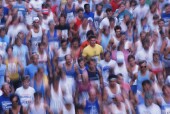Marathoners at Slim Risk of Cardiac Arrest
10-year study found distance running safe for most participants
 WEDNESDAY, Jan. 11 (HealthDay News) -- If you're a healthy distance runner, your chances of dying from sudden cardiac arrest during a race are extremely slim, a new study indicates.
In the last decade, one of every 259,000 runners who competed in a U.S. marathon or half-marathon died, the researchers found. And most who collapsed had underlying heart disease.
The findings should reassure those who participate in the sport -- and many do, with more than 450,000 U.S. finishes a year, according to David Watt, executive director of the American Running Association.
The study began in 2000, led by Dr. Aaron Baggish, director of the Cardiovascular Performance Program at Massachusetts General Hospital in Boston. The researchers analyzed the cardiac arrests suffered among competitors in marathons (26.2 miles) or half marathons (13.1 miles) through 2010.
Of nearly 11 million U.S. distance runners, 59 had a cardiac arrest, meaning their heart suddenly stopped beating. Forty occurred in full marathons, and the average age of the stricken runners was 42. Men were at significantly higher risk than women.
Forty-two of the cardiac arrests (71 percent) were fatal, found the study, published in the Jan. 12 issue of the New England Journal of Medicine. The average age of those who died was 39, compared with 49 for arrest survivors.
For the study, yearly statistics on race participation, provided by the trade association Running USA, went into a database. Researchers identified cardiac arrest cases through a combination of methods, including public search engines and contact with race directors.
They interviewed racers who survived cardiac arrest, or next of kin, and looked at medical records and autopsy data. This information was available for 31 of the 59 affected runners.
A condition called hypertrophic cardiomyopathy was the definite or likely cause of death for 15 runners, they determined. The condition is the most common cause of sudden cardiac death in young athletes.
Hypertrophic cardiomyopathy is essentially an overgrown heart muscle, which usually comes from some genetic abnormality, explained Dr. Kirk Garratt, clinical director of interventional cardiology research at Lenox Hill Hospital in New York City.
Nine who died of hypertrophic cardiomyopathy had additional heart conditions, such as obstructive coronary artery disease, congenital disorders and myocarditis, an inflammation of the heart muscle.
"One interesting finding: prevalence of coronary artery disease was low," Garratt said.
One runner died of heat stroke and another of hyponatremia, which can occur when a person drinks too much fluid, without taking in enough sodium. Two were presumed to have died of arrhythmia, an abnormal heart rhythm.
A key factor in survival was receipt of cardiopulmonary resuscitation (CPR) from race bystanders, said Baggish, the cardiologist for the Boston Marathon.
"We're actually going to be for the first time offering CPR training to runners this year who come to Boston for our marathon," Baggish said.
Prompt defibrillation is also crucial, said study co-author Dr. William Roberts, a professor of family medicine at the University of Minnesota and medical director of the Twin Cities Marathon. At that race, "you're always within a mile of a defibrillator," he said.
Every year new races crop up, especially half-marathons, Watt said. And they attract a different breed of runner.
"Today's runner is older, slower, committed to going to more events, possibly not as athletic," he said. Some are "experiential" or social runners who come to bond, race for charities or lose weight.
In the study, men had a cardiac arrest rate of 0.16 arrests per 100,000 runners, nearly double that of women, but still extremely small.
Garratt had some reservations about the study methodology. "They went to a racing agency for the denominator. Then they went to a variety of sources, including Internet-based sources. To make it worse, for about half of the incidents, they were unable to get complete clinical information," he said.
Roberts acknowledged that their data didn't take marathon preparation into account. "How do we know how many people we lose with shorter [training] races?" he asked.
He said that with proper conditioning, distance running "is safe if you listen to your body, if you don't try to push through chest pain or shortness of breath, or if you don't ignore factors like very high cholesterol."
"All runners, whether they're young or old, should have a discussion with their doctors about their intent to run and in that discussion there should be a very clear assessment of risk factors," Baggish said.
More information
The Cleveland Clinic offers advice on marathon fitness preparation  . .

|